Plant Kingdom Class 11 Notes Biology Chapter 3
Topics and Subtopics in Class 11 Biology Chapter 3 Plant Kingdom:
| Section Name | Topic Name |
| 3 | Plant Kingdom |
| 3.1 | Algae |
| 3.2 | Bryophytes |
| 3.3 | Pteridophytes |
| 3.4 | Gymnosperms |
| 3.5 | Angiosperms |
| 3.6 | Plant Life Cycles and Alternation of Generations |
| 3.7 | Summary |
1.Basis of Classification and Algae, Bryophytes & Pteridophytes
Our understanding of the plant kingdom has changed over time. Fungi and members of the Monera and Protista having cell walls have not been separated form Plantae, the earlier classifications kept them in the same kingdom. The kingdom-Plantae has been described under algae, bryophytes, pteridophytes, gymnosperms and angiosperms. The overview of this classification is demonstrated here in the flowchart.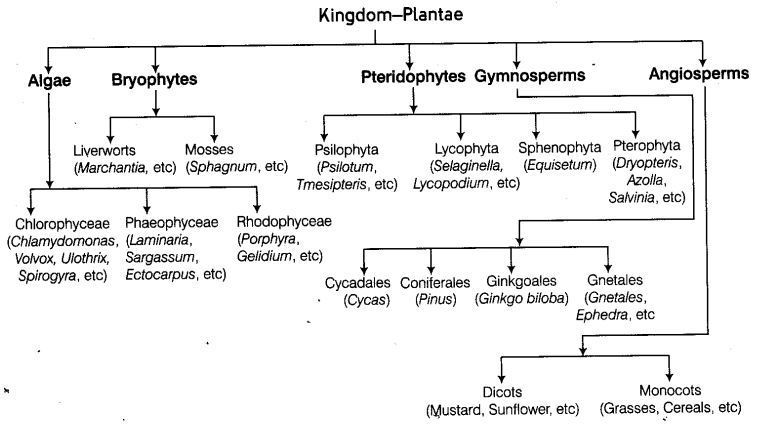
Types of Classification System
These includes artificial system, natural system and phylogenetic system of classification.
The various systems used in classification ofiplants are being discussed here
1. Artificial System of Classification
This system is based on comparison of one or a few superficial characteristics, which are helpful in easy identification of organisms. This system remained in use for about two thousand years.
Aristotle is known as father of Zoology.
Carolus Linnaeus is known as father of Taxonomy.
Advantages
Advantages of artificial system as below
(i) Artificial system is easy to remember as only one or few characters are used.
(ii) The traits used are of interest to humans.
Disadvantages
Disadvantages of artificial system are given below
(i) This system use only few superficial characters (i.e., habits, numbers, colours and shapes of leaves, etc) which leads to many orgarfisms grouped together,
(ii) They considered mainly the vegetative characters or the androecium characters as given by linnaeus.
(iii) It does not demonstrate natural and phylogenetic relationships.
(iv) This gave equal weightage to vegetative and reproductive/sexual characters this is not acceptable, as vegetative characters are more easily influenced by the environmental factors.
(v) They sparated the closely related species.
2 Natural System of Classification
It is also known as phenetic system of classification. The natural system of classification is based on natural affinities among the organisms. It considers both external and internal features like structure, anatomy, embryology and phytochemistry.
Advantages
Advantages of natural system are given below
(i) Only related organisms are kept in a group.
(ii) Unrelated organisms are kept in separate groups.
(iii) It shows natural relationships among the organisms.
(iv) It shows possible origin of different taxa.
Disadvantages
Disadvantages of natural system are given below
(i) There is more emphasis given on natural character.
(ii) In this system several related families are separated and unrelated families are put together.
(iii) Evolutionary basis is neglected.
3. Phylogenetic System of Classification
The phylogenetic system of classification indicates the evolutionary as well as genetic relationships among organisms. This system is based on fossil records of biochemical, anatomical, morphological, physiological, embryological and genetical.
The system was initiated by Engler and PrantI (1887-1899) in Die Naturalichen Pflanzefamilien. In phylogenetic system, flowering plants are placed in ascending series related to complexity of floral morphology. The phylogenetic system of classification are mainly the rearrangement of taxonomic characters in addition to the phylogenetic information.
Advantages
Advantages of phylogenetic system are given below
(i) Families and order in this system are of small size.
(ii) This system is in conformation with the modern views of phylogeny.
(iii) They use information from various sources to solve problems of classification. Such informations become more important in the absence of supporting fossil evidences.
Disadvantages
Disadvantages of phylogenetic system are given below
(i) This is not helpful in plant identification.
(ii) The classification is outdated as the habit is used as . main basis of classification.
Types of Taxonomies
For the suitability in studies various categorizations has been done in taxonomy.
The important taxonomies are as follows
1. Numerical Taxonomy
It is carried out by quantitative assessment of similarities and differences in order to make objective assessments. It is now easily carried out using computers based on all observable characteristics. Number and codes are assigned to all the characters and the data are then processed. In this way, each character is given equal importance and at the same time hundreds of characters can be considered.
2. Cytotaxonomy
Cytotaxonomy is based on cytological information like chromosome number, structure, behaviour and type of chromosomes. For example,
(i) Chromosome number is constant for a species, e.g., 46 in man, 48 in apes and potato, 20 in maize, 16 in onion and 8 in Drosophila.
(ii) Behavior of chromosomes was used by taxonomists during pairing and banding patterns to understand the relationships between species, e.g, Origin of humans from apes, origin of wheat, etc.
3. Chemotaxonomy
It is the system based on the evidences from chemical constituents (enzymes, hormones, proteins, amino acids, etc.), some specific chemicals (usually secondary metabolites) and the chemical nature of proteins have been utilised to establish similarities and relationships. For example, the presence of raphides has been found to be common in 35 families of plants.
Algae
Algae are chlorophyll-bearing, simple, thalloid, autotrophic and largely aquatic (both freshwater and marine) organisms.
The important salient features of algae are given below
Habitat
These are found in both freshwater and marine habitats. Some algal forms are also found in moist habitats like wet rocks and soil, tree trunks, etc. Some of them are also found in close association with fungi (lichen) and animals {e.g., on sloth bear).
Thallus Organisation
The plant body (thallus) is without differentiation. The basic form and size of algae is highly variable, and ranges from filamentous {e.g., Ulothrixand Spirogyrd) to colonial {e.g., Volvox). These are attached on the substratum with the help of holdfast.
Structure of Algal Cell
It has an eukaryotic plant cell structure. The cytoplasm contains membrane bound chloroplast, mitochondria, ER, Golgi bodies and other cell organelles. The cell wall contains cellulose. The nucleus contains nuclear membrane.
Food Material
Algae have main food reserve as starch. In brown algae, mannitol and laminarin are the main reserve food material, whereas in red algae floridean starch is the reserve food material.
Reproduction
The algae reproduces vegetatively, asexually and sexually.
i. Vegetative Reproduction
It occurs by fragmentation, tubers, stolons, adventitious branches, etc. Each fragment gets develop into a thallus.
ii. Asexual Reproduction
It occurs by a number of accessory spores, such as zoospores aplanospores, akinetes, carpospores, etc.
The most common being the zoospores, which are flagellated. The cells which produce spores are called sporangia. The sporangia may be the vegetative cells (e.g. in Chlamydomonas and Ulothrix) or modified vegetative cells (e.g. in Vaucheria).
iii. Sexual Reproduction
It occurs by fusion of two gametes.
On the basis of morphology of reproductive cells, sexual reproduction is of two types
(a) Isogamy In this method, two morphologically similar gametes fuse to form a zygote, e.g., Spirogyra.
(b) Heterogamy In this process, fusion occurs between morphologically as well as physiologically different gametes. It is of two types
Anisogamy It is the fusion of structurally dissimilar gametes, which differ in size and – behaviour. Male gamete is more active and female gamete is less active and bigger in size, e.g., Some species of Chlamydomonas.
* Oogamy In this process, the male gamete is motile, active, small and without reserve food.
The female gamete is bigger, passive, non-motile and laden with food, e.g., Volvox, Fucus.
Embryo and Life Cycle
An embryo stage is not present. Life cycle is haplontic, diplontic, diplohaplontic, haplohaplontic, etc. An alternation of generation occurs in diplohaplontic life cycle.
Economic Importance of Algae
(i) Algae are responsible for carrying out about a half of the total carbon dioxide fixation on earth by the process of photosynthesis.
(ii) Some forms of marine brown and red algae produce large amount of hydrocolloids. These are algin (brown algae) and carrageenan (red algae) which have many commercial uses.
(Hi) The algae Gelidium and Gracilaria are used to produce agar, which is used in preparation of ice creams and jellies.
(iv) Some protein rich algae, like Chlorella and Spirullina are used as food supplements by sailors and space travellers.
(v) About 70 species of marine alga are used as food, e.g., Porphyra, Laminaria and Sargassum.
Classification of Algae
Algae are divided into various classes based on pigmentation, stored food and flagellation. The three main classes are
Chlorophyceae, Phaeophyceae and Rhodophyceae.
i.Class-Chlorophyceae (Green Algae)
The members of Chlorophyceae are commonly called green algae.
There are about 7000 species in this class. The reserve food material is starch.
The characteristic features of Chlorophyceae are discussed below
(a) Habitat These are mostly marine forms, only some are freshwater. Chlorella can tolerate moderately warm waters. Snow dweling forms are called cryophytes, e.g., Chlamydomonas nivalis, Scotiella, etc.
(b) Cell Organisation These are unicellular, colonial, coenocytic and multicellular forms. Cell walls contain cellulose (inner layer) and pectose (outer layer) in most of the green algae. The chloroplasts may be discoid, plate-like, reticulate, cup-shaped, spiral or ribbon shaped.
The chloroplasts contain pigments. Most of the members have one or more storage bodies called pyrenoids located in” the chloroplasts. Pyrenoids contain protein besides starch. Some algae may store food in the form of oil droplets also.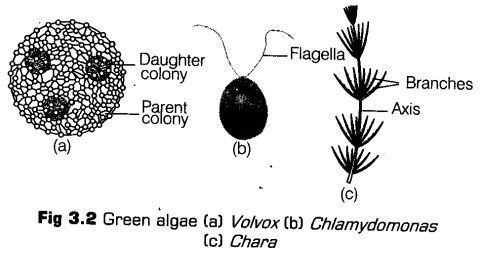
(c) Thallus Unicellular green algae can- be flagellate, (Chlamydomonas), unicellular, non-flagellate (Chlorella).
Acetabularia (umbrella plant) has unicell upto 10 cm long with distinction of nucleus containing rhizoid, elongated stalk and umbrella like cap.
A colony for fixed number of individual unicells (Volvox) is called coenobium. Coenocytic or siphonaceaus thallus occurs in Caulerpa. Unbranched filamentous thallus in Ulothrix and Spirogyra, Cladophora, heterotrichous in Stigeoclonium and parenchymatous in Ulva.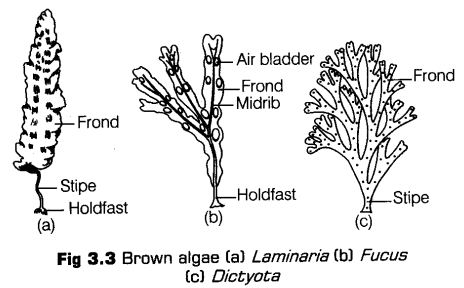
(d) Reproduction The members of Chlorophyceae reproduce vegetatively, asexually and sexually by various methods.
* Vegetative reproduction occurs through cell division (unicellular forms), fragmentation, stolons, tubers, storage cells, etc.
* Asexual reproduction occurs by zoospores, aplanospores, hypnospores, akinetes and daughters colonies.
* Sexual reproduction may be isogamous, anisogamous or oogamous.
(e) Life Cycle It can be haplontic, diplontic and diplohaplontic. In haplontic life cycle, there is a single somatic phase, which is haploid. Diploid stage is represented by a single cell or zygote, e.g., In Spirogyra.
ii. Class-Phaeophyceae (Brovin Algae)
The members of Phaeophyceae are fucoxanthin and phycocolloid rich multicellular eukaryotic algae. Its common members are seaweeds called kelps. This class is comprised of about 2000 species.
(a) Habitat Brown algae are mostly marine. These are found mostly in colder seas or during cold seasons in tropical regions.
(b) Size They range from simple branched, filamentous forms (Ectocarpus) to profusely branched forms as represented by kelps. These represent largest algae. The largest kelps are Macrocystis (40-100m) and Nereocystis (20-30 m).
(c) Cell Organisation All members are multicellular. Cell wall is composed of cellulose, pectose and phycocolloids. The cellulosic wall of vegetative cells is usually covered on the outside by a gelatinous coating of algin.
(d) Thallus It is heterotrichous filament with both prostrate and upright branches (Ectocarpus). The parenchymatous structure is found in higher forms.
The plant body of large forms often differentiated into holdfast (with which it usually attaches to the substratum) a stalk called the stipe and lamina (frond), which is photosynthetic. Conducting tubes or trumpet hyphae are present in larger brown algae or kelps. They help in conduction of food materials.
(e) Photosynthetic Pigments and Colour These include chlorophyll-4, c and carotenoids. They ranges in colour from olivt green to various shades of brown depending upon the amount of the xanthophyll pigment, fucoxanthin present in them.
(f) Food Reserve It remains in the form of complex carbohydrates such as laminarin or mannitol.
(g) Flagellation These contain heterokont flagellation with one smooth (whiplash) and one tinsel flagella.
(h) Reproduction Vegetative reproduction occurs through fragmentation (e.g., Sargassum), adventitious branches and stolons (e.g, Dictyota). Asexual reproduction by biflagellate zoospores, which are pear-shaped having two unequal laterally attached flagella.
Sexual reproduction is performed by isogamy, anisogamy and oogamy. Union of gametes may take place in water or within the oogonium (oogamons species). The gametes are pyriform (pear-shaped) and have two laterally attached flagella.
(i) Life Cycle Isomorphic alternation of generation is found in some brown algae, e.g, Ectocarpus, Dictyota. In many brown algae, the diploid generation or phase is dominant. The haploid phase is either microscopic or represented by gametes only (e.g., Fucus).
Economic Importance of Pheophyceae
* The brown algae that are used as food are Laminaria, Nerocystis, Macrocystis, Alaria, etc.
* Some brown algae like Fucus, Sargassam, Laminaria, Macrocystis are important fodder for catde.
* Brown algae are collected from sea shores and used as manure. They improve mineral content of soils.
* Alginic acid is a phycocolloid obtained from a number of brown algae such as Alaria, Macrocystis, Ascophyllum, Laminaria. It is used as emulsifier, thickener, gelating agent in toothpastes, shaving creams, ice-creams, emulsion paints, shampoo, cosmetics, etc.
* Fucus and Laminaria are rich in iodine.
iii. Ciass-Rhodophyceae (Red Alqae)
The members of Rhodophyceae are commonly called red algae because of the predominance of the red pigment,i.e., r-phycoerythrin in their body.
(a) Habitat Most of the red algae are marine with greater concentrations found in the warmer areas. They are found in both well lighted regions close to the surface of water and also at great depths in oceans where relatively little light penetrates.
(b) Thallus The red thalli of most of the algae are multicellular. Some of them have complex body organisation like Asterocystis is pseudofilamentous, Porphyridium is unicellular, Porphyra has parenchymatous sheets, Cbondrus is ribbon like, Gelidium is a multicellular sea weed.
(c) Cell Wall The cell wall contains cellulose, pectic compounds and certain mucopolysaccharides called phycocolloids, such as agar, carrageenin, etc. In many algae, cell wall contains pits.
(d) Photosynthetic Pigments These include chloro¬phyll-4, carotenes, xanthophylls and phycobilins. Phycobilins are water soluble and are of two types, i.e., red-coloured phycoerythrin and blue-coloured phycocyanin.
(e) Reserve Food It is floridean starch similar in constitution to glycogen and amylopectin. if) Reproduction Vegetative reproduction occurs by fragmentation, regeneration of hold fast and gemmae. Asexual reproduction occurs by non-motile spores (carpospores, monospores, tetraspores and neutral spores).
Sexual reproduction occurs by non-motile gametes and is oogamous type. The male sex organs is called spermatogonium or antheridium. The male produced is non-flagellated, called as spermatium. The female sex organ is called carpogonium. After fertilisation, a new structure called carposporophyte is produced. It remains attached to the parent alga.
(g) Life Cycle Life cycle has two or more phases such as haplohaplontic, haplohaplohaplontic, diplodiplohaplontic, etc.
Economic Importance of Red Algae
* The red algae like Porphyra, Chondrus, Rhodymenia, Centerella and Bostrychia are used as food in various parts of the world.
* Agar yielding algae are called aerophytes, such as Gelidium, Gracilaria, Ceramium, Gelidiella, etc.
* Alga like Rhodymenia are used as fodder for cattle.
* Carrageenin a phycocolloid obtained from red algae like Chondrus and Gigartina is used in preparations of emulsions for ice cream, chocolates, sauces, toothpastes, cosmetics, etc. It is also used in clearing liqueurs and finishing leather, etc.
* Funori an adhesive phycocolloid is obtained from red alga Gloiopeltis. It is used in sizing textiles, paper and as glue.
* Some algae like Corallina, Polysiphonia have medicinal properties.
Bryophytes
Bryophytes include the various mosses and liverworts. These are non-vascular embryophytes, characterised by the presence of. an independent gametophyte and parasitic sporophyte.
Habitat
Bryophytes commonly grow in -moist, shaded areas in hills. These are also called amphibians of the plant kingdom because, these can live in soil but are * dependent on water for sexual reproduction.
Rhizoids
These are attached to the substratum by unicellular or multicellular rhizoids.
Sex Organs
The main plant body produces gametes, hence it is called gametophyte. The sex organs in bryophytes are multicellular, the male sex organs in bryophytes is called antheridium (which produces biflagellate antherozoids) and the flask-shaped female sex organ is called archegonium (produces a single egg).
Reproduction
It is of sexual type reproduction. The antherozoids are released into water where they come in contact with archegonium.
Fertilisation
It occurs inside the archegonium. The egg secretes a chemical which attracts spermatozoids. Sperms require a thin film of water for swimming and reaching the dehisced archegonium. One sperm fuses with an egg and produces a diploid zygote. Zygotes do not undergo reduction division immediately instead, they produce a multicellular body called sporophyte.
Dependent Sporopbvrc The sporophyte is not free-living but attached to the photosynthetic gametophyte deriving nourishment from it. Some cells of the sporophyte undergo reduction division (meiosis) to produce haploid spores (which germinate to produce gametophyte).
The sporophyte of bryophytes is called sporogonium because it is mainly dependent and meant for producing spores.
Life Cycle
Bryophytes have heteromorphic or heterologous alternation of generation. The gametophyte may be produced directly or first from a juvenile stage called protonema.
Economic Importance
Bryophytes in general are of little economic importance. But, several species have some uses.
(i) Some mosses provide food for herbaceous mammals, birds and other animals.
(ii) Species of Sphagnum (a moss), provides peat that
have long been used as fuel. It has the capacity to hold water as packing material for transshipment of living material.
(iii) Mosses along with lichens are the first organisms to colonise rocks. Hence, these help in biological succession. They decompose rocks making the substrate suitable for the growth of higher plants.
(iv) Mosses from dense mats on the soil, they reduce the impact of falling rain and prevent soil erosion.
(v) Marchantia has medicinal properties to cure lungs and liver infections. It also has antitumour properties.
Bryophytes do not attain great heights. They may range of 0.4 to 70 cm and have thalloid body.
The reasons may be following
(i) Root is absent.
(ii) Vascular tissues are not present.
(iii) Cuticle is not present on the plant body.
(iv) Absence of mechanical tissue.
(v) Male gametes need to swim upto the interior of dehisced archegonia.
Types of Bryophytes
The bryophytes are generally classified into two main groups
i. Liverworts
Liverworts (Hepaticopsida) usually grow in moist, shady places such as banks of streams, marshy ground, damp soil, bark of trees and deep in the woods.
(a) Thallus The plant body of a liverwort is thalloid, e.g, Marchantia,. The thallus is dorsoventral and closely appressed to the substrate. The leafy members have tiny leaf like appendages in two rows on the stem like structure.
(b) Rhizoids These are unicellular. These may be of two types in some liverworts, i.e. smooth walled and tuberculate.
(c) Reproduction It may occur both by asexual and sexual means.
• Asexual Reproduction It occurs by fragmentation of thalli or by the formation of specialised structures called gemmae (sing, gemma). Gemmae are green, multicellular, asexual buds which develop in small receptacles called gemma cups located on the thalli. The gemmae become detached from the parent body and germinate, forming new individuals.
• Sexual Reproduction During this male and female sex organs are produced either on the same or on different thalli. The sporophyte is differentiated into a foot, seta and capsule. After meiosis, spores are produced within the capsule.
• These spores germinate to form free-living gametophytes, e.g., Riccia, Marchantia, Pellia, Porella, etc.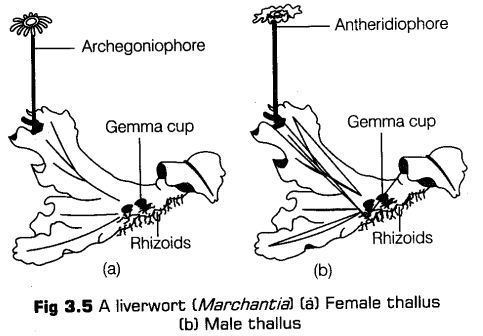
ii. Mosses
Mosses (Bryopsida) grow in dense mats over moist shady places, especially during rains. Some mosses grow in desert bogs and streams.
(a) Plant Body The predominant stage of the life cycle of a moss is the gametophyte which consists of two stages the first stage is the protonema stage which develops directly from a spore. It is a creeping, green, branched and frequently filamentous stage; the second stage is the leafy stage which develops from the secondary protonema as a lateral bud. They consist of upright, slender axes bearing spirally arranged leaves. This stage bears sex cells.
(b) Rhizoids These are long, multicellular branched structures with oblique septa. They take part in fixation and absorption of water. However, surface conduction through capillarity is an important mechanism of water supply to aerial parts.
(c) Reproduction This can occur both by vegetative and sexual means.
* Vegetative Reproduction It occurs by fragmentation and by budding in the secondary protonema from exposed rhizoids and other parts (like gemmae, buds and tubers).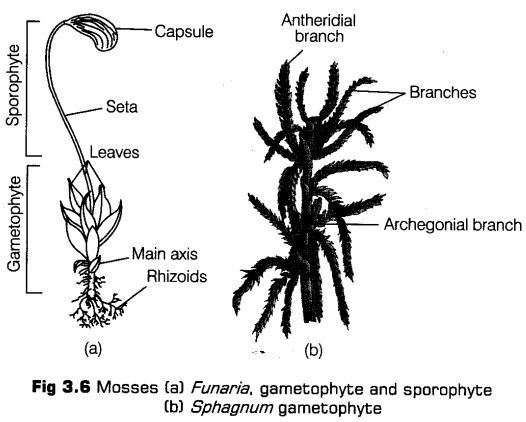
Sexual Reproduction Sex organs, antheridia and archegonia are produced at the apex of the leafy surface. Male organs appear cup-shaped, while female organs are bud-like. After fertilisation, the zygote develops into a sporophyte, consisting of foot, seta and capsule (containing spores).
(d) Sporophyte The sporophyte in mosses is more elaborate than that in liverworts. Spores are formed after meiosis. The mosses have an elaborate mechanism of spore dispersal, e.g., Funaria, Polytrichum and Sphagnum.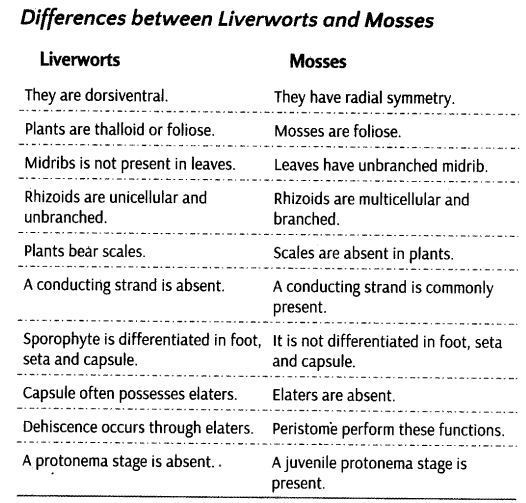
Pteridophytes
Pteridophytes are primitive seedless vascular plants also called cryptogams. These have conspicuous sporophytic plant body, inconspicuous independent gametophytes with antheridia and partially embedded archegonia having 4-rowed necks.
The term Pteridophyte was coined by Haeckel (1866). There are about 13000 species of pteridophytes have been reported. They were perhaps the first land plants evolved during ordovician (450-500 million years ago) period.
The characteristic features of pteridophytes are as follow
Habitat
The pteridophytes are found in cool, damp shady places though some may flourish well in sandy-soil conditions.
Some members like Azolla, Salvinia, Marsilea species.
Plant Body
The size varies from a fraction of centimeter (e.g, Azolla) to 20 m in tree ferns (e.g, Angiopteris). The main plant body is a sporophyte which is differentiated into true root, stem and leaves. These organs possess well differentiated vascular tissues. The leaves are small (microphyllus) as in Selaginella or large (macrophylls) as in ferns.
Vascular Tissues
These are xylem and phloem present throughout the body. Xylem consists of tracheids and phloem is made up of sieve cells and albuminous cells.
Sporophylls
The sporophytes bear sporangia that are subtended by leaf like appendages called sporophylls. In some cases sporophylls may form distinct compact structure called strobili or cones (Selaginella and Equisetuni). The sporangia produce spores by meiosis in spore mother cells.
Spores
The spores germinate to give rise to inconspicuous, small but multicellular free-living, mostly photosynthetic thalloid gametophytes called prothallus. In majority of the pteridophytes, all the spores are of similar kinds; such plants are called homosporous. Genera like Selaginella and Salvinia which produce two kinds of spores, macro (large) and micro (small) spores; such plants are called heterosporous.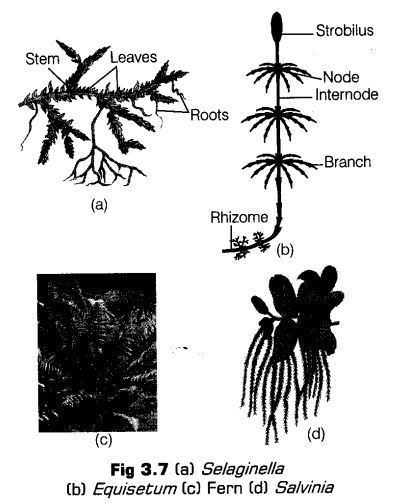
Gametophyte
The thalloid gametophyte or prothallus require cool, damp, shady places to grow. The megaspores and microspores germinate and give rise to female and male gametophytes respectively. The female gametophytes in these plants is retained on the parent sporophytes for viable periods. In most ferns, prothallus is green and autotrophic. In heterosporous ferns, the female gametophyte depends on food stored by the megaspore.
Sex Organs
The gametophytes bear male sex organs called antheridia and female sex organs called archegonia. Antheridium is sessile and surrounded by a single layered jacket. Archegonium is flask-shaped. It is partially embedded.
Fertilisation
Water is required for transfer of antherozoids. The male gametes released from the antheridia and reach to the mouth of archegonium. Fusion of male gamete with the egg present in the archegonium result in the formation of zygote. Zygote therefore, produces a multicellular, well differentiated sporophyte, which is the dominant phase of the pteridophytes.
Embryo
Fertilisation produces a zygote that undergoes division to produce embryo. The development of the zygote into young embryo takes place within the female gametophyte.
* This event is a precursor of the seed habit and considered as an important step in evolution, e.g., Dryopteris, Selaginella, Adiantum, Equisetum and Salvinia.
Economic Importance of Pteridophytes
(i) Pteridophytes are a good source of food for animals. For example, sporocarps of Marsilea is edible. Angiopteris and Alsophila have starchy pith eaten by natives of Australia.
(ii) Ferns protect soil from erosion by providing a good cover on the hill slopes and other fragile places.
(iii) Equisetum stems have rough surfaces. They are used in scrubbing and polishing.
(iv) Azolla a water fern has a symbiotic association with nitrogen fixing cyanobacterium Anabaena azollae. It is cultured in paddy fields to harbour nitrogen fixing bacterium. Thus, act as a biofertiliser.
(v) Rhizomes and petioles of Dryopteris are used to produce anthelmintic drug. Roots of Adiantum can cure throat infections. Lycopodium is used in treatment of rheumatism and disorders of lungs and kidneys.
(vi) Ferns are also grown as ornamental plants for their graceful plant body.
Classification of Pteridophytes
The pteridophytes are further classified into four classes
(i) Psilopsida (Psilotum)
(ii) Lycopsida (Selaginella and Lycopodium)
(iii) Sphenopsida (Equisetum)
(iv) Pteropsida (Dryopteris, Pteris and Adiantum)
Differences between Bryophytes and Pteridophytes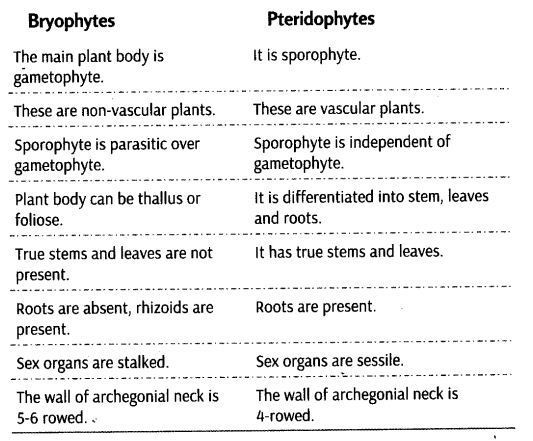
2 Gymnosperms, Angiosperms and Plant Life Cycles
Gymnosperms
The gymnosperms (Gymnos = naked; sperma = seeds) are plants in which the ovules are not enclosed by any ovary wall and remain exposed, both before and after fertilisation. These are small groups of seed plants which are represented by only 900 living species. Unlike bryophytes and pteridophytes, in gymnosperms the male and the female gametophytes do not have an independent free-living existence. They remain within the sporangia retained on the sporophytes.
Habitat
These plants are mostly found in colder parts of northern hemisphere, where they form extensive forests. A number of gymnosperms are now, known as ornamentals, e.g., Ginkgo, Thuja, Araucaria, etc.
Morphology
Gymnosperms include, medium-sized trees or tall trees and shrubs. The giant red wood tree Sequoia is one of the forest tree upto 100 m. Species of Gnetum are woody climbers. The smallest gymnosperm is Zamia pygmaea which reaches a height of 25 cm. Many of the gymnosperms live for more than 4000 years, e.g, Pine (Pinus), redwood {Sequoia).
External Features
The plant body is sporophyte and differentiated into root, stem and leaves.
Plant Body
Tap roots are present for proper anchorage to heavy plant. Roots in some genera have fungal association in the form of mycorrhiza {Pinus), while in some others {Cycas) small specialised roots called coralloid roots are associated with N2-fixing cyanobacteria such as Anabaena, Nostoc, etc.
The stems are branched {Pinus, Cedrus) or unbranched {Cycas). The leaves may be simple or compound.
Archegonia
The megaspore mother cell thus, undergo meiotic division forming four megaspores. Out of which one is enclosed within the megasporangium (nucellus) and develops into a multicellular female gametophyte, bearing two or more archegonia of female sex organs.
The multicellular female gametophyte is also retained within megasporangium.
Fertilisation
Air current required for transport of male gametes. The male gametes are carried to the archegonia, i.e., gamete in the ovule by means o’f a tube called pollen tube and discharge their contents near the mouth of the archegonia. This is called siphonogamy.
Seeds
Following fertilisation, zygote develops into an embryo and the ovules into seeds. The seeds contain food laden tissue called endosperm. It lies naked or exposed. Endosperm provides nourishment for growth of seedling at the time of seed germination.
Examples Cycas, Pinus, Ginkgo, Ephedra, Gnetum, Vaucheria, Cedrus, Abies, etc.
Differences between Microsporophyll and Megasporophyll
Classification of Gymnosperms
Gymnospermsfurther include three main classes Cycadopsida (cycads), Coniferopsida (conifers) and Gnetopsida (Gnetum).
Differences between Male Gametophyte of Pteridophyte and Gymnosperms
Male Gametophyte of Pteridophyte Male Gametophyte of Gymnosperms
A distinct male gametophyte may not be present. A distinct male gametophyte is present.
It contains an antheridium. Antheridium is not present.
Male gametes are flagellate. Male gametes can be flagellate or non-flagellate.
Male gametes reach female gametes by swimming in water. Male gamete reach the female gamete through a pollen tube.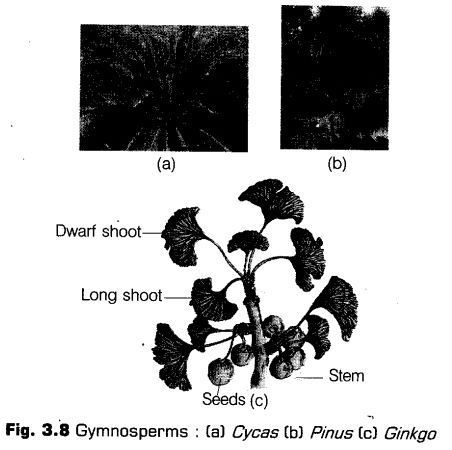
Economic Importance of Gymnosperms
(i) Seeds of Pinus gerardiana (chilgoza) are used a food after roasting. Some other edible gymnosperms plant part are endosperm of Ginkgo, seed kernel of some Cycas and Gnetum, sago grains from stems of Cycas, etc.
(ii) Gymnosperms provide softwood for construction, plywood and paper industry.
(iii) Branches of gymnosperm trees are used as fuel food.
Saw dust of conifers is used in making plastics and linoleum.
Resin is a semifluid secreted by special tubes of a number of conifers. It helps in sealing female cones after pollination, scale leaves around leaf bases and apical buds. Resin is distilled to obtain turpentine and resin. Turpentine is used for . thinning paints, varnishes, etc., and resin is used
for sealing joints, wheel green, preparation of writing paper, oil clothes, etc.
(iv) Ephedrine an antibiotic is obtained from Ephedra. It is used for curing respiratory problems and asthma. Taxol is an anticancer drug obtained from Taxus.
Angiosperms
Angiosperms are seed bearing plants or flowering plants. Unlike gymnosperms where the ovules are naked, in angiosperms the sporophyll are organised into flowers and the seeds are produced inside fruits. There are about 250000 species of angiosperms in the nature. They evolved about 130-160 million years ago.
Habitat
Angiosperm are found in wide range of habitats, from the land to up to 6000 m in Himalayas or Antarctica and Tundra, dry hot deserts, cold deserts, tropics, fresh water up to 60°C, underground, over other plants as parasites, saprophyte, etc. Zostera is a marine angiosperm.
Plant Body
These plant are sporophytic, in the form of herbs, shrubs, trees, climber creepers, etc. The smallest angiosperm is water plant Wolffia and tallest is Eucalyptus regnans (100 mand above). Primary root develops from radicle. It forms tap root system. In many angiosperms roots develop from places other than radicle, these are adventitious roots. Stem develops from plumule.
Leaves
These are simple or compound. The leaves bear axillary buds which can grow into stem branches.
Vascular Tissues
Angiosperms have vessels in xylem. Phloem contains sieve tubes and companion cells in regard to gymnosperms which do not have companion cells.
Flowers
Flowers are the reproductive structures formed by the union of one or both types of sporophylls (microsporophylls or stamens and megasporophylls or carpels).
Microsporophylls or Male Sex Organs
Stamens are considered as the male sex organs of a flower. Each stamen has two main parts, i.e., a slender filament with an anther (at the tip). An anther contains four microsporangia where microspore mother cells become differentiated to form four microspores, each developing into a pollen grain.
Megasporophylls or Female Sex Organs
Carpel or pistil is called the female sex organ of the flower. Each carpel has three parts {i.e., an ovary, style and stigma). A megaspore mother cell is differentiated in the nucellus and undergoes meiosis, ultimately one functional megaspore gets enlarged and forms the female gametophyte known as embryo-sac.
Each cell of an embryo sac is haploid:
Embryo Sac
Each embryosac contains a three celled eg® apparatus consisting I of one egg cell and two synergids, three antipodal cells (at the i opposite end) and two polar nuclei (in the central cell). The polar : nuclei eventually fuses and forms diploid secondary nucleus.
Pollination
Pollen grains after dispersal from the anthers are carried by various ways such as wind, water or by various other agencies to the stigma of the pistil.
Fertilisation and Development of a Seed
Each pollen grain germinates on the stigma forming a pollen tube that carries two male gametes to the embryo sac, growing through the tissues of stigma and style.
One of the male gametes fuses with the egg cell to form a zygote (syngamy).
The other male gamete fuses with the diploid secondary nucleus to produce the triploid Primary Endosperm Nucleus (PEN). Because of the involvement of above mentioned two events, it is known as double fertilisation. After fertilisation, synergids and antipodal cells degenerate.
The zygote develops into embryo and the primary endosperm nucleus develops into an endosperm.
The ovule gradually transforms into a seed and the ovary becomes the fruit. A fruit is actually a ripened ovary. They not only protect the seed but also help in their dispersal.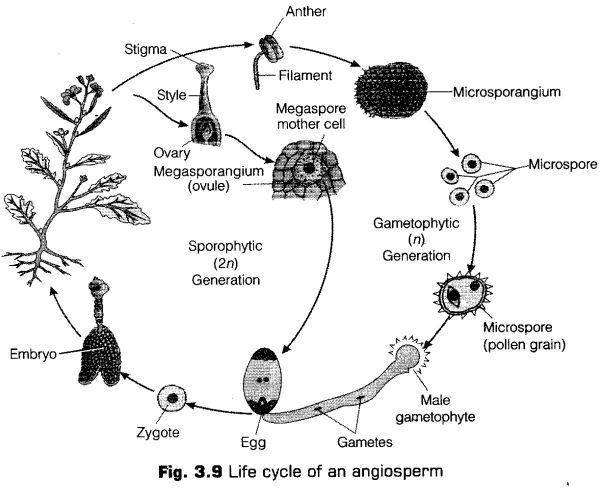

Classification of Angiosperms
George Bentham and Joseph Dalton Hooker presented the system of classification of angiosperm* published in Genera Plantarum (1862-1883) which appeared in three volumes.
This system of classification is used by most of the well known Herbaria of the world. The details of this system are not described here. Conveniently, on the basis of the number of cotyledons angiosperm are classified in two broad groups i.e., Monocotyledonae and Dicotyledonae.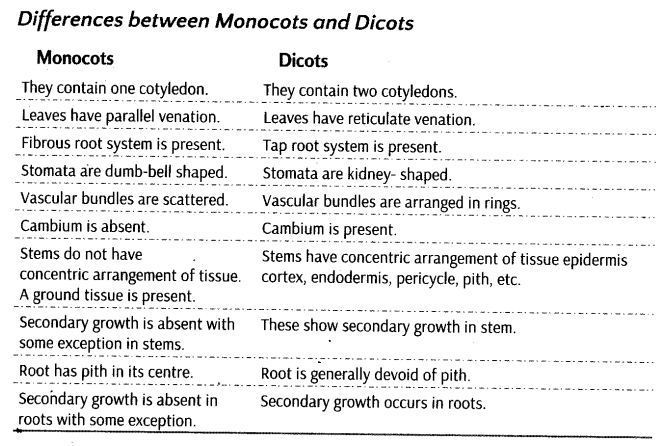
Economic Importance of Angiosperms
(i) The angiosperms are major source of food, fibers, spices and beverages.
(ii) They also provide valuable timber and medicines.
(iii) These also add beauty to our environment as well.
Alteration of Generation
Life cycle of an organism is a sequence of events that occur from birth to death of an organism. In plants, both haploid and diploid cells can divide by mitosis.
This feature leads to the formation of different plant bodies haploid and diploid. The haploid plant body produces gametes by mitosis. This plant body represents a gametophyte.
After fertilization, zygote also divides by mitosis to produce a diploid saprophytic plant body. Haploid spores are produced by this plant body by meiosis. These in turn, divide by mitosis to form a haploid plant body once again.
Thus, during the life cycle of any sexually reproducing plant, there is an alternation of generation between gamete producing haploid gametophyte and spore producing diploid saprophyte.
Plant Life Cycles
Different plant groups and individual have different features in their life cycle
Haplontic
The dominant photosynthetic phase is a gametophyte produced by haploid spores. The gametophyte produces gametes by mitosis.
The gametes fuse and produce a diploid zygote, that represents sporophytic generation. There are no free living sporophytes. Meiosis in the zygote results in formation of haploid spores. This kind of life cycle is called haplontic.
Many algae such as Volvox, Spirogyra and Chlamydomonas represent this pattern of life cycle.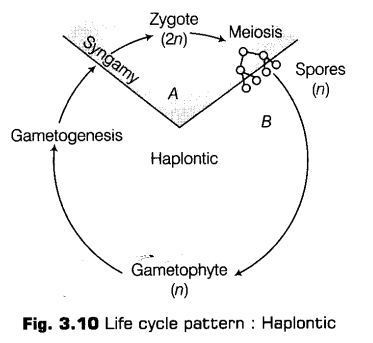
Diplontic
In this type, the diploid sporophyte is the dominant. The multicellular diploid phase is called sporophyte. The gametophytic phase is represented by the single to few celled haploid gametophyte.
This kind of life cycle is termed as diplontic. All seed bearing plants, gymnosperms and angiosperms follow this pattern of life cycle. Fucus, an alga is diplontic.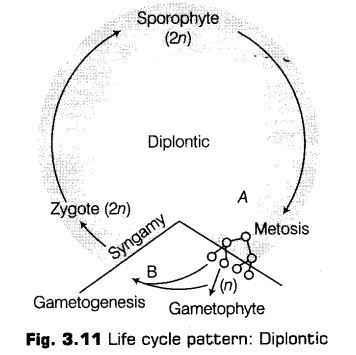
Haplodiplontic
In this type, there are two distinct multicellular phases, diploid sporophyte and haploid gametophyte are present. Both phases are multicellular. However, they dilfer in their dominant phases.
(i) A dominant, independent, photosynthetic, thalloid or erect phase is represented by a haploid gametophyte. It alternates with the short lived multicellular sporophyte totally, partially or dependent on the gametophyte for its anchorage and nutrition. All bryophytes represent this pattern.
(ii) The diploid saprophyte is represented by a dominant independent photosynthetic vascular plant body. It alternates with multicellular saprophytic/autotrophic,
independent but short lived haploid gametophyte. This pattern is called haplodiplontic life cycle.
All pteridophytes demonstrate this pattern. However, most algal genera are haplontic, some of them such as Ectocarpus, Polysiphonia and kelps are haplodiplontic.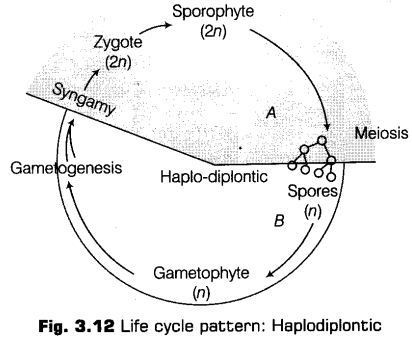
CBSE Class 11 Biology Chapter-3 Important Questions
1 Marks Questions
1. Define gemma.
Ans. Gemma are green, multicellular, asexual buds which develop in receptacles called as gemma cups.
2. Which group of plants is regarded a first lerrestrial plank ? Why?
Ans. Pteridophytes. As they possess vascular tissues – xylem and phloem.
3. The gametes and spores of phaeophyceae have a distinct morphology. Give its name.
Ans. Pyriform (pear-shaped). Bear two laterally attached flagella.
4. Which substance has ,structural similarity to floridean starch ?
Ans. Amylo pectin and glycogen.
5. Name the organisms which exhibit heterospory and seed habit.
Ans. Selaginelia and Salvinia.
6.Name seedless vascular plants.
Ans. Pteridophytes.
7.Which pigment is responsible for red colour of red algae?
Ans. Phycobilin, phycoerythrin & phycocyanin.
8.What is a cone?
Ans. The fruiting body of gymnosperms which consists of micro & megasporophyll are called as cone.
9.Name a unicellular algae.
Ans. Chlamydomonas
10.Why some bryophytes are called liverworts.
Ans. Some bryophytes are called liverworts as they are liver shaped eg. marchantia.
11.What are rhizoids?
Ans. Rhizoids are slender, unicellular or multicellular hair like structure, which penetrate in the moist soil & absorb the water for plants.
12.Name the algae which is used for fodder to poultry birds.
Ans. Laminaria.
13.Which groups of plants is called vascular cryptogam ?
Ans. Pteridophyta.
14.What is a cone ?
Ans. The fruiting body of gymnosperm which consists of micro & megasporophyll are called as clone.
15.What are cone bearing plants called?
Ans. Conifers
16.Name any red algae which is used as vegetables?
Ans. Porphyra
17.What do you mean by thallus?
Ans. It is a plant body which is not differentiated into root, stem & leaves.
18.Name the vascular plants which produces only spores but no flowers or seeds?
Ans. Pteridophytes.
19.Where are the antheridia & archaegonia located in ferns?
Ans. Prothallus
20.What are the two main classes of bryophytes?
Ans. Liverwort & Mosses.
2 Marks Questions
1. Sphagnum has lot of economic importance. Justify.
Ans. Provide peat used as fuel: used as packing material for trans- shipment of living material.
2. Gymnosperms can show polyembryony. Why do you think so.
Ans. Have two or more archegonia, so polymebryony call occur.
3. How is leafy stage formed i mosses? flow is it different fro protonema?
Ans. Leafy stage develops from secondary protonema as a lateral bud. Protonema is creeping, green, branched frequently fiIamentous stage whereas leafy stage is upright with spirally arranged leaves,
4. What features led to dominance of vascular plants?
Ans. Three important features have to dominance of Angiosperm:-
(i) Development of deep roots capable of penetrating the soil.
(ii) Development of water- proofing material eg. cutin on aerial surfaces, to reduce water loss through evaporation.
(iii) Development of strong woody material anchor & support above ground structures.
5.Differentiate between Red algae & brown algae?
Ans.
| RED ALGAE | BROWN ALGAE |
| i) mostly unicellular & microscopic | i) filamentous & heterotrichous. |
| ii) Phycoerythrin, phycocyanin & phycobilin pigments are present. | ii) fucoxanthin pigment is present. |
| Ii iii) Reserve food material is Floridian starch | iii) Reserve food material is Laminarian starch. |
| iv) chlorophyll ‘a’ present | iv) chlorophyll ‘a’ absent |
| v) eg. Gelidium, polysiphonia | v) Laminaria, focus & sargassum |
6. Give some important features of dicots?
Ans. The dicotyledons are characterized by either woody or herbaceous habit, their flower parts usually are in four or five their leaves are net-veined, vascular bundles are arranged in a circle or ring within the stem. The dicots have two cotyledons in their seeds.
7.List four classes of plants belonging to fern group.
Ans. Pteridophytes or fern group are divided into four classes:-
(i)Class 1: psilopsida eg. psilotum nudum.
(ii)Class 2: Lycopsida eg. Lycopodium phlegmaria.
(iii)Class 3: Sphenopsida eg. Equisetum
(iv)Class 4: pteropsida eg. Adiantum & pteridium
8.How will you differentiate between red algae & green algae.
Ans.
| RED ALGAE | GREEN ALGAE |
| i) It belongs to rhodophyta | i) It belongs to chlorophyta |
| ii) Phycoerythrin, phycocyanin, phycobilin & chlorophyll ‘a’ is present. | ii) Chlorophyll ‘a’ & ‘b’ with  -carotene & carotinoids are present. -carotene & carotinoids are present. |
| iii) Reserve food material is Floridian starch | iii) Reserve food material is starch. |
| iv) Unicellular & microscopic but few are filamentous & heterotrichous | iv) Unicellular or multicellular may be motile & flagellated |
| v) eg. geladuim, porphyra. | v) eg. spirogyra, Volvox |
9.Write two important characteristics of gymnosperms?
Ans. (i)It is a group of vascular plant which possess naked seeds attached to surface of megasporophyll
(ii)Megasporophyll is not folded to form on ovary so there is no fruit formation
10.How do fungi differs from algae ?
Ans.
| Algae | Fungi |
| i) Chlorophyll present so they are green | i) chlorophyll absent so they are non- green. |
| ii) Autotrophic nutrition | ii) Saprophytic or parasitic nutrition |
| iii) Absorbs inorganic & mineral salts | iii) Absorbs organic or mineral salts |
| iv) Eg chlamydomonas, ulothrix | iv) Eg. albugo & yeast |
11.Both gymnosperms & angiosperm bear seeds but then why are they classified separately?
Ans. The gymnosperms are plants that bears ovules which are not covered by any ovary wall & remain exposed. The seeds of gymnosperms are not covered that is they are naked but in the Angiosperm, the seeds remains closed inside the fruit so these are classified seperalely.
12.List any three characterstic features of Bryophytes.
Ans.(i) They are small, erect plant growing in moist shady places
(ii)They have no leaf like, stem like or root like structure.
(iii)Most plants are gametophytes. They develop from haploid spores.
13.List any two differences’ between gymnosperms & angiosperms?
Ans.
| Gymnosperm | Angiosperm |
| i) Seed plants without flowers & with naked seeds. | i) Angiosperms are known as flowering plants which have covered seeds |
| ii) There are about 9000 species of gymnosperm | ii) There are about 250,000 sp. Of angiosperm. |
| iii) Eg. cycas, Pinus | iii) Eg. delonix, Rosa. |
14.What is the role of capsule in life history of moss?
Ans. Capsule is an important structure of sporophyte of moss plant. In the capsule, spores are produced. When the capsule ripens its dehiscence takes place & spores are liberated by winds. The spores develop favorable conditions into protonema.
15.What is the difference between syngamy & triple fusion?
Ans. Syngamy is fusion of male gamete (sperm) to the female gamete (egg) to form a zygote while triple fusion is fusion of another male gamete to the diploid secondary nucleus to form primary endosperm nucleus.
16.Mention some of the uses of ferns?
Ans. (i)Ferns are much used by florists for decoration.
(ii)They are also grown as ornamental plants.
(iii)Wood from tropical tree fern are used as building material because it resists termite decay.
(iv)Ferns are used as astringent during childbirth to stop bleeding.
(v)Maiden hair fern is a source of expectorant.
17.Tabulate differences between Gymnosperm & pteridophytes.
Ans.
| Gymnosperm | Pteridophytes |
| (i) found in temperate climatic region | (i) found is shady & moist places |
| (ii) cambium present | (ii) cambium lacking |
| (iii) pollentube is formed | (iii) pollen tube is not formed |
| (iv) Neck canal cells are absent | (iv) Neck canal cells are present |
18.What is heterospory? What is its significance?
Ans. Heterospory refers to the production of two kinds of spores in pteridophytes eg. salivinia and selaginella produces two kinds of spores macrospores & microspores. These mega & microspores germinate & then give rise to male & female gametophytes. The female gametophyte is retained on parent sporophyte for variable period of time. So, this event is a precursor to seed habit.
19.What are gymnosperms? What are its four classes?
Ans. Gymnosperms are vascular plants with naked seeds. The seeds are exposed on surface of sporophyll. The reproductive organs are usually borne in cones on which spores are spirally arranged. Gymnosperms are classified into four groups Conifers, Cycads, Ginkgo, Gnetophytes.
20.How would you distinguish between monocots & dicots?
Ans.
| Monocots | Dicots | |
| Root | Aaventitious | Tap roots |
| Stem | Soft & herbaceous | Woody & herbaceous |
| Leaf | Parallel | Reticulate Venation |
| Floral parts | Trimerous | Tetra – or pentamerous |
| Cotyledons. | One cotyledon | Two cotyledon |
| seeds | Endospermic seeds | Non – endospermic seeds. |
3 Marks Questions
1. The leaves in gymnosperms are adapted to withstand xerophytes conditions. Justify.
Ans. Gymnosperms like conifers have needle shaped Ieaves to reduce surface area, thick cuticle and sunken stomata to reduce water loss.
2. The gametophytes of bryophytes and pteridophytes are different from that of gymnosperms. How?
Ans. Male and female gametophyte have free existence in bryophytes and pteri- dophytes but not in Gymnosperms.
3. Roots m some gymnosperms have fungal or algal association. Give examples, their names and role in the p1ants.
Ans. Pinus has fungal association to form mycorrhiza which helps ii absorption of water and minerals.
Cycos has cy in its roots which forms coralloid roots and helps in nitrogen fixation.
4.Explain in brief the structure of prothallus of fern?
Ans. Prothallus of Fern:-
(i)It is a heart-shaped structure.
(ii)The sex organs are present on the lower surface of the prothallus below the apical notch.
(iii)Sex organs are antheridia & archaegonia.
(iv)Prothallus is produced from the meiospore as gametophyte of fern.
(v)Below the sex organs are rhizoids
(vi)Archegonia are flask shaped but antheridia are globose.
(vii)Male & female gametes are produced in antheridia & archegonia.
5.Point out differences in sexual reproduction of moss & fern?
Ans.
| MOSS (Bryophyte) | Fern (pteridophytes) |
| i) Sex organs are borne on the gametophytic plant body. | i) Sex organs are borne on an inconspicuous gametophyte or prothallus which represents an alternate phase to sporophytic plant body. |
| ii). Antheridia are well developed & often possess a stalk. | ii). Antheridia are less developed & mostly devoid of a stalk. |
| iii). Antheridial jacket made up of several cells | iii). Antheridial jacket mostly made up of only 3 – cells. |
| iv). Sperms biflagellate | iv). Multiflagellate sperms |
| v). Archegonia often have stalk | v). Archegonia do not have stalk |
| vi). Neck is 6 – rowed | vi). Neck is 4 – rowed. |
6.Describe the main features of pteridophytes?
Ans. (i)They are small sized & occur in humid & tropic climate mostly growing as epiphytes.
(ii)The plant body is divided into root, stem & leaves.
(iii)Some ferns appears like small trees.
(iv)Lycopoduim, selaginella & equistem are some members of pteridophytes.
(v)The leaves are of two types compound leaves & sporophylls.
(vi)Plant body is sporophytic.
(vii)They are vascular cryptograms.
(viii)Alternation of generation is present.
(ix)Prothallus represent gametophytic phase.
(x)Pteridophyta is divided into 4- classes :- psilopsida, lycopsida, sphenopsida & pteropsida
7.“Algae & Bryophytes are different from each other.” Point out the main differences between them?
Ans.
| ELGAE | BRYOPHYTES |
| i) Mostly aquatic | i) mostly terrestrial, found in damp, shady places. |
| ii) Thallus single celled to branched filaments | ii) Thallus made of parenchymatous cells. |
| iii) No tissue differentiation | iii) Tissue differentiation well marked |
| iv) Stomata absent | iv) Stomata present |
| v) Rhizoids absent | v) Rhizoids present |
| vi) Asexual reproduction by aplanospores or zoospores. | vi) Asexual reproduction absent |
| vii) Sexual reproduction isogamous anisogamoes or oogamous. | vii) Sexual reproduction is of oogamous type |
| viii) No embryo formed after fertilisation | viii) Embryo formed after fertilization |
| ix) Eg. ulothrix, volvox, ulva, chladophora | ix) Eg. Ruccia, marchantia, funaria, porella |
8.What are the identifying features of Angiosperms flowering plants.
Ans. (i)Majority of the plants around us are Angiosperms.
(ii)flowering plants show great number of diversities in habitat, habits, forms, duration of life, mode of nutrition etc.
(iii)The plants with stem varying from a few mm to metre or so in height are termed as herbs, medium sized plants with woody stem are termed as shrubs & tall woody plants are known as trees.
(iv)Plants which live for a year or part of year are termed annual, which live for two year are termed as biennials & which live more than two years are termed as perennials.
(v)Plants which live in extremely dry conditions are termed as Xerophytes; plants living in water are termed as hydrophytes; those living in moderate conditions are termed as mesophytes.
(vi)All flowering plants have roots, stem & leaves. They produce flowers, seeds & fruits..
(vii)The economic uses of plants are varied. Plants provide us with materials for our food, clothing & shelter.
9.Describe the similarities in sexual reproduction of moss & fern.
Ans. (i)Oogamous mode of sexual reproduction which involves fertilization of non- motile female gametes ar egg by means of a motile male gamete or sperm.
(ii)In both the male sex organ consists of a jacket of sterile cells that enclose a spermatogenous tissue.
(iii)Sperms are flagellate.
(iv)Female sex organ or archaegonia are flask shaped with tubular neck & a swollen basal venter. Venter encloses a single egg or oosphere & sterile venter canal cell. Neck has one or more neck canal cell.
(v)Are external source of water is needed for the swimming of the sperms so as to reach the open archegonia.
(vi)Dependence of the embryo upon gametophytic phase.
(vii)Occurrence of hetromorphic or heterologous alternation of generation.
10.Why are Bryophytes regarded as “the amphibians of plant kingdom”?
Ans. Amphibians live on land & water with equal case but they must come to water during the breeding season to lay their egg. Water is therefore, essential for amphibians for breeding.
In the same way, bryophytes live on land but they must get water for completing their life history because only through the medium of water antherozoides reaches the archegonia & fertilise the egg. If therefore, water is not available to bryophytes during the period they shall not survive so on account of this similarity the bryophytes are called as “Amphibians of plant kingdom”
11.Describe the important characterslics of gymnosperms?
Ans.(i)They grow in cool & warm climate in hills & in plains.
(ii)Gymnosperms are evergreen woody & perennial plants
(iii)They have well developed vascular system but compared to seed plants their xylem has no vessel & phloem is without companion cell.
(iv)Plants are heterosporous.
(v)Conifers are cone bearing trees eg. pines, cedrus fir.
(vi)They usually have evergreen needle like leaves which are well adapted to withstand extremes of temperature, humidity & wind.
(vii)Reduction of gametophytic generation.
(viii)The leaves have a reduced surface area thick cuticle & sunken stomata to conserve moisture & reduce the water loss by transpiration.
(ix)Ovules are exposed to receive pollen grains.
(x)Gymnosperms possess exposed or naked seeds.
(xi)Polyembryony is common occurrence.
12.List common modes of reproduction in Algae?
Ans. Reproduction in algae occurs by the following method:-
(i)Vegetative reproduction:- It occurs by fragmentation, zoospores, aplanospares palmella stages etc. akinites are also formed in asexual reproduction.
(ii)Sexual Reproduotion in chlamydomonas:- In chlamydomonas, the flagellated & motile gametes which are isogamous unite to form a quadriflagellate zygote. It is converted into zygospore. When the flagella are lost & a cyst wall is formed around it zygospore germinate by meiosis to form four haploid meiospores.
(iii)Palmella stage:- If the conditions are unfavourable, the daughter cells instead of forming zoospore divided repeatedly into numerous cells. Their walls become gelatinous & cells remains together. This stage is called palmella stage. On return of favourable conditions, the cells inside the gelatinous mass & develop cilia.
(iv) Asexual Reproduction in chlamydomonas:- It takes place by formation of zoospores In the formation of zoospores, the cilia from chlamydomonas are withdrawn. The cell content divide into 4 & 8 daughter cells. In this way, they become motile & called as zoospores.
13.What are ferns? Describe its salient features.
Ans. Ferns are found in warm moist tropical region & dry rocky places. The plant body is distinguished into three parts- i) underground stem rhizome ii) it bear roots & iii) it sends caerial shoots with leaves. Leaves of ferns are of two types- a) simple leaves with single vein & b) compound leaves with several leaflets. The sporophyte phase is dominant in ferns. On underside of leaflets are borne sori which contains sporangia. Where the spores are produced after meiosis division, the sporangium has an annulus. It is made of band of thickened cells that dry out pulling it open. So spores are released. These spores germinate into a porthallus the gametophyte. The gametophyte bears antheridia & archaegmia on underside. The antheridia bear flagellated sperms & egg lies at the base of archaegonia. The process of fertilization occurs when water is available for flagellated sperms to swim to reach the egg.
14.Differentiate between Red, Brown & Green algae.
Ans.
| RED ALGAE | BROWN ALGAE | GREEN ALGAE |
| i) Mainly marine | i) Marine form | i) Freshwater mostly |
| ii) Only few are unicellular | ii) Unicellular forms almost exist | ii) Unicellular species are more |
| iii) Thylakoid unstacked | iii) Occurs in group of three | iii) stacked in groups of 2-20 |
| iv) Only chlorophyll a present | iv) chlorophyll a & c present | iv) Chlorophyll a & b present |
| v) fucoxanthin present | v) Fucoxanthin present | v) Fucoxanthin absent |
| vi) Phycobilin present | vi) Phycobilin absent | vi) Phycobilin absent |
| vii) Reserve food is starch | vii) Reserve food is laminarin | vii) Reserve food is starch |
| viii) Motile stages are not observed | viii) Present | viii) Present. |
5 Marks Questions
1.Explain the life cycle in green algae?
Ans. There are three types of life cycle are found in green algae:-
(a)HAPLONTIC LIFE CYCLE:- The dominant phase is haploid. Diploid state is found only in the form of zygote or zygospores. Meiosis takes place at time of its germination. Eg. ulothrix, spirogyra.
(b)DIPLONTIC LIFE CYCLE:- The dominant phase alga is diploid. It gives rise to haploid gametes through meiosis. Gametes unit & the zygote regenerates diploid phase.
(c)DIPLOHAPLONTIC LIFE CYCLE:- It has well developed multicellular haploid & diploid phase. These are respectively called gametophyte & sporophyte. Haploid gametophyte produce haploid gametes. Fusion product of gametes grows directly into diploid sporophytes. Sporophytes produce haploid spores by meiosis. The meiospores germinate into new gametophyte.
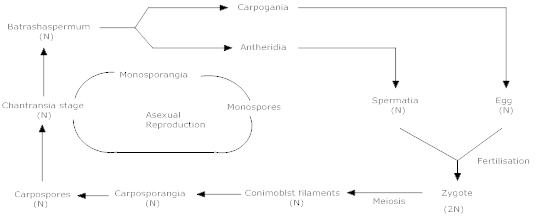
2. Explain briefly the alternation of generation in bryophytes?
Ans. The life cycle of moss represesents two distinct generations GAMETOPHYTIC & SPOROPHYTIC. Moss plant is a gametophyte. Spore is the beginning of gametophytic generation. It develops into protenema which give rise to male & female gametophytes. Gametophyte consists of green thallus having archegoniophores & antheridiophores which bear sex organs & the gametes are produced in them either monoecious or diecious. Club shaped antheriduim bears biflagellate sperms or antherozoids. Flask shaped archegonium encloses the female egg. Zygote is formed after the fertilization of male & female gametes with the help of water. Repeated divisions of the zygote give rise to the embryo (2N) which soon develops into sporophyte. The sporophyte of moss gets differenliated into three parts foot seta & capsule. Inside the capsule single celled spores are produced. After the dehiscence, they begin to germinate & give rise to protonema to start the cycle again. Gametophytic Generation alternates the sporophytic generation.
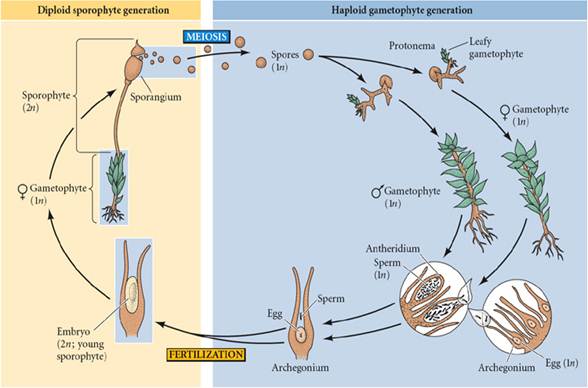
3.Describe the common mode of reproduction in Angiosperms.
Ans. Stamens & pistils are the two reproductive parts of a flower. The stamen consist of a slender filament with anthers at the tip. Each pistil is made of three parts- ovary, style & stigma. Ovary contains one to many ovules. Each ovule contains megaspore mother cell it produces four haploid megaspores after meiosis of them three degenerate & remaining one is functional megaspore. It divides by meiosis forming megagametophyte. It consists of 8 haploid nuclei embedded in cytoplasm of which 3 cells lie at the micropylar end & 3 antipodal lie at chalazal end. The two remaining nuclei move to centre to make a diploid nucleus.
The anthers have pollen sac & contains many microspore mother cells. Each of them produces four haploid microspores after meiosis & each becomes a microgametophyte. It contains two nuclei generative nucleus & tube nucleus. The pouen iscarried away by air & other agencies & reaches stigma of pistil of same or difference plants. This process is called pollination. Pollen grains germinates & produces a pollen tube it grows within style & reaches ovule of ovary. The generative nucleus divides pollen tube producing two male gametes.
On reaching ovule, pollen tube burst to release male gamtes. One of the two gametes fertilise egg & forms a diploid zygote. Other male gamete fertilizes with polar nuclei to form triploid endosperm. This is known as double fertilization.
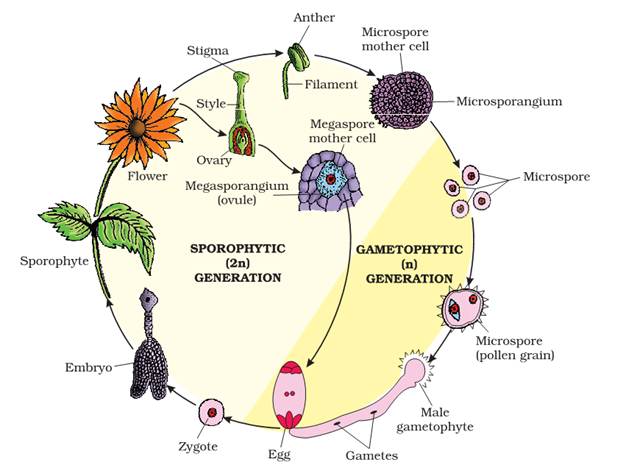
4.Classify plant kingdom?
Ans.

(i)Thallophytic:- plant body is thallus i.e. not differentiated into root, stem & leaves eg. chlorella, ulothrix, spirogyra etc.
(ii)Bryophyta:- Amphibious in habit, water is necessary for fertilization, Vascular tissues are absent eg. Riccia, Marchantia, funaria.
(iii) Pteridophyta:- plant body is differentiated into distinct underground stem like rhizome bearing roots & aerial shoots with leaves. They are called “primitive vascular plants “ eg. equistem, Adiantum, pteris
(iv)Gymnosperm:- seeds are naked eg. cycas, pinus, cedars
(v)Angiosperm:- seeds are protected inside the friuts eg.(i) monocotyledones eg. grass, maize, rice & (ii). Dicotyledons eg gram, pea, sunflower.
NCERT TEXTBOOK QUESTIONS SOLVED
1.What is the basis of classification of algae?
soln. Fritsch (1935), has classified algae considering phylogeny, affinities and inter-relationships of various forms. He classified algae mainly on the basis of the characters like structure of plant body, nature of the pigments, reserve food material, number and position of flagella, chemistry of cell wall and methods of reproduction etc. Algae is divided into 11 classes but among them 3 main classes are Chlorophyceae, Phaeophyceae and Rhodophyceae.
2.When and where does reduction division take place in the life cycle of a liverwort, a moss, a fern, a gymnosperm and an angiosperm?
soln.All of these plants show life cycle with one gametophytic (n) generation and one sporophytic (2n) generation. Reduction division or meiosis that produces haploid (n) cells from diploid cells (2n) is necessary in their life cycles to restore gametophyte generation after sporophytic generation. It occurs in different body structures according to the basic body design of these groups. Reduction division in a liverwort and moss takes place at the end of the sporophytic generation, where haploid spores are formed by reduction division of spore mother cell inside capsule. Spores germinate to produce dominant gametophytic generation. Reduction division in fern takes place at the end of the dominant sporophytic generation inside the sporangium from spore mother cell by reduction division. Spores may be of one type (homospory) or of two types (heterospory).
Reduction division in gymnosperms takes place at the end of dominant sporophytic generation. Megaspore and microspores are produced by the reduction division of diploid megaspore mother cell and diploid microspore mother cell respectively, inside megasporangium and microsporangium. Reduction division in angiosperms takes place at the end of dominant sporophytic generation. The haploid pollen grain or microspore and the haploid egg cell are produced by the reduction division of diploid (microspore) mother cell and diploid megaspore mother cell respectively. Microsporic division occurs inside anther and megasporic division occurs inside gynoecium (ovary).
3.Name three groups of plants that bear archegonia. Briefly describe the life cycle of any one of them.
soln. The three groups of plants that bear archegonia are bryophytes, pteridophytes and gymnosperms.
Life cycle of a bryophyte is as follows : The main plant body of bryophyte is gametophytic (n), which is independent and may be thallose (no differentiation in root, stem, leaves) e.g., Riccia, or may be foliose (having leafy axis) e.g., Funaria. The dominant phase in the life cycle of Funaria is the gametophyte, which occurs in two stages, the protonema stage and the erect, leafy gametophytic plant.
The leafy gametophyte consists of an upright, slender axis (stem-like) that bears spirally arranged leaves and is attached to the substratum by multicellular, branched rhizoids. Vegetative reproduction takes place
by fragmentation; by the buds formed in secondary protonema etc. The sex organs, antheridia and archegonia are produced in dusters at the apices of the leafy shoots. Antheridia produces antherozoids and archegonia produces egg. Antherozoid (male gamete) and egg (female gamete) fuses and form zygote.Zygote develops into a sporophyte; which is differentiated into foot, seta and capsule and spores are produced in the capsule.
Spores on reaching a suitable substratum germinate to produce a filamentous juvenile stage, .called the primary protonema, which later produces secondary protonema that forms erect leafy plants.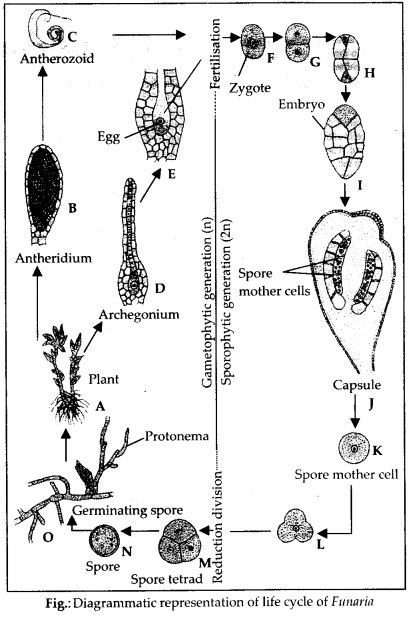
4.Mentiontheploidyofthefollowingrprotonemal cell of a moss; primary endosperm nucleus in dicot, leaf cell of a moss; prothallus cell of a fern; gemma cell in Marchantia; meristem cell of monocot, ovum of a liverwort, and zygote of a fern.
soln. Protonemal cell of a moss – haploid. Primary endosperm nucleus in dicot – triploid.
Leaf cell of a moss – haploid.
Prothallus cell of a fern – haploid.
Gemma cell in Marchantia – haploid. Meristem cell of monocot – diploid.
Ovum of a liverwort – haploid.
Zygote of a fern – diploid.
5.Write a note on economic importance of algae and gymnosperms.
soln. Economic importance of algae is as follows:
The group Algae plays both economically beneficial as well as harmful roles.
Beneficial importance :
(i) People of coastal countries have been using sea weeds & certain other algae as source of food, e.g., Porphyra, Ulva, Laminaria, etc.
(ii)Some algae are used as food for marine as well as domestic animals, e.g., Sargassum, Macrocystis.
(iii)Algae are useful source of many commercial products like agar, a jelly like substance (complex polysaccharide) is extracted form species of red algae belonging to the genera Gelidium, Gracilaria etc. Agar is also used as base in culture media. Carrageenin occurs as a cell wall polysaccharide, esterified with sulphate. It is extracted from red alga like Chondrus Crispin, etc. is used in pharmaceutical emulsifier and textile, leather, cosmetic industries. Alginates are salts of alginic acid found in the cell wall of phaeophyceae (brown algae) like Fucus, Laminaria etc.
(iv)Algae are also useful in medicine industry. Antibiotic chlorellin is obtained from Chlorella. Extracts of Cladophora, Lyngbya kill strains of Pseudomonas and Mycobacterium like bacteria. Nitella is used to destroy mosquitoes growth in ponds and hence used in control of malaria.
(v) Some algae are used in agriculture like Nostoc, Anabaena etc. are used to convert atmospheric N2 into nitrogenous compounds which are absorbed by higher plants. Some sea weeds like Fucus, Litlwphyllum, Lycophyllum etc. are rich io K, P, trace elements and growth substances and are used as fertilisers by coastal people.
(vi)Some algae like Chlorella, Chlamydomonas, etc. are used in sewage disposal in ponds. These algae help in bacterial decomposition by providing 02.
(vii)Some algae like Chlorella, Synecoccus, etc are used in space travels. A person inside a spaceship will need a device to get rid of C02 and other body wastes and will require sources of Oz and food. These algae are very useful for this purpose.
(viii)A large amount of iodine (mineral element present in thyroxine hormone of thyroid gland) is extracted from kelps (brown sea weeds or members of phaeophyceae) like Laminaria, Fucus, Ascophyllum etc. Similarly red algae like Rhodomela, Polysiphonia, Rhodymenia are sources of bromine.
Harmful importance:
(i) Some blue green and green algae like Chroococcus, Oscillatoria grow over the surface of water bodies in abundance and cause water bloom. On death and decay these algae give off bad smell. Some algae secrete poisonous or toxic substances.
(ii)Parasitic algae like Cephaleuros virescens causes red rust of tea, coffee etc.
Economic importance of gymnosperms is as follows:
(i)Some species of Cycas like C. revoluta, C. rumphii look like palm tree and are used for decoration purposes as they remain fresh for long period.
(ii)Stem portion of Cycas revoluta is a good source of ‘sago’, a kind of starch used in making bread by poor people. Seeds of some species of Cycas are roasted and taken as food. Young succulent leaves of some species of Cycas are cooked as vegetable.
(iii)Many gymnospersm have medicinal value. The fresh juice extracted from the Cycas circinalis leaves is used as medicine for stomach disorders, blood vomiting and other skin diseases. Pollen grains of some Cycas plants are reported to have some narcotic effect.
(iv)Some gymnosperms like Pinus, Abies, Cedrus are the chief source of various types of woods. The wood of Juniperus is used in making pencils, scales, holders etc.
(v)Some species of Pinus is a good source of turpentine, wood gas, wood alcohol.
6.Both gymnosperms and angiosperms bear seeds, then why are they classified separately?
soln.’Gymnosperms and angiosperms both bear seeds but they are classified separately because gymnosperms are a group of plants in which the ovules are freely exposed on open megasporophylls, whereas in angiosperms the seeds or ovules are enclosed within ovary which later forms the fruit.
7.What is heterospory? Briefly comment on its significance. Give two examples.
soln. The occurrence of two kinds of spores in the same plant is called as heterospory. Among them the smaller spore is called microspore and the larger spore is called megaspore. Heterospory first evolved in pteridophytes. Significance of heterospory
(i) Heterospory is associated with the sexual differentiation of gametophyte /.<?., a microspore develops into a male gametophyte whereas a megaspore develops into a female gametophyte.
(ii)In homosporous pteridophytes spores have to germinate on soil thus face more environmental problems. In heterosporous pteridophytes, spores germinate within the sporangium and the gametophytes are retained inside for variable periods of time. Hence, germinating gametophyte has better chances of survival. This lays the foundation of complete retention of gametophytes within sporophytes in angiosperms and gymnosperms.
(iii)Heterospory is the basis of development of seed habit in higher plants.
8.Explain briefly thefollowing terms with suitable examples.
(i) Protonema (ii) Antheridium
(iii)Archegonium (iv) Diplontic (v) Sporophyll (vi) Isogamy
soln. (i) Protonema : It is the first, usually branched, green and filamentous structure produced by a germinating moss or fern spore. The protonema of mosses bears buds that develop into the gametophyte plant. In fern the protonema becomes the prothallus.
(ii)Antheridium : The male sex organ of cryptogams (algae, fungi, bryophytes and
pteridophytes) is known as antheridium. It produces the male gametes or anthero- zoids. It may consist of a single cell or it may have a wall that is made up of one or several layers forming a sterile jacket around the developing gametes.
(iii)Archegonium : The multicellular flask shaped female sex organ of bryophytes, pteridophytes and many gymnosperms is known as archegonium. Its dialated base called the venter contains the female gamete or egg or oosphere. The cells of the narrow neck of archegonium liquify to allow the male gametes to swim towards the oosphere.
(iv)Diplontic : It is the kind of life cycle in which the diploid sporophyte is dominant and this diploid phase is photosynthetic. The gametophytic phase is represented either by gametes only, that are formed through meiosis or by a highly reduced few celled gametophyte. E.g., all seed-bearing plants (gymnosperms and angiosperms).
(v) Sporophyll : It is a type of leaf bearing sporangia. In ferns, the sporophylls are the normal foliage leaves, but in other plants the sporophylls are modified and arise in specialised structure such as the strobili of club-moss, gymnosperms and the flower of angiosperms. In most plants sporophylls are of two types – microsporophylls and megasporophylls.
(vi)Isogamy: It is a type of sexual reproduction where fusion takes place between two identical gametes. The gametes are similar in size and structure and they show equal motility during sexual reproduction, e.g., Spirogyra (algae).
9.Differentiate between the following:
(i) Red algae and brown algae
(ii)Homosporous and heterosporous pteridophytes
(iii)Liverworts and moss
(iv)Syngamy and triple fusion.
soln.(i) The differences between red algae and brown algae are as follows :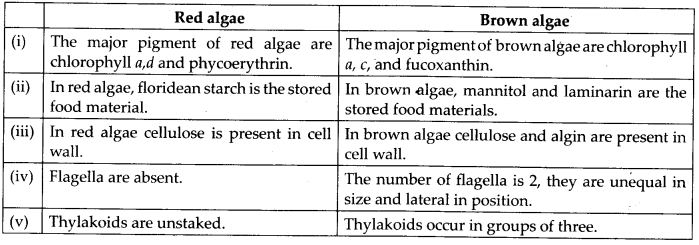
(ii) The differences between homosporous and heterosporous pteridophytes are as follows:
(iii) The differences between liverworts and mosses are as follows :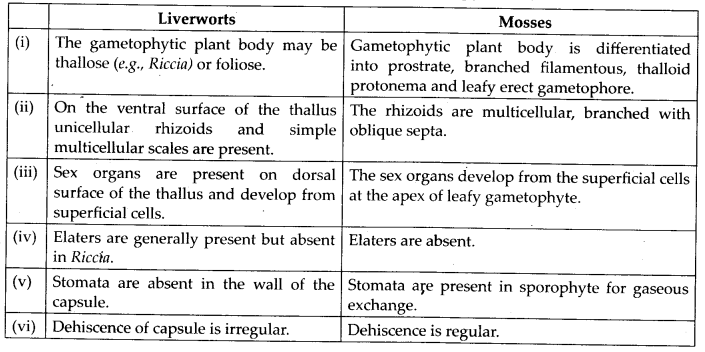
(iv) The differences between syngamy and triple fusion are as follows :
10.How would you distinguish monocots from dicots?
Soln. Differences between monocots and dicots are as follows :
11.Match the following (Column I with Column II).
Column I Column II
(a)Chlamydomonas (i)Moss
(b)Cycas (ii)Pteridophyte
(c) Selagmella (iii)Algae
(d) Sphagnum (iv)Gymnosperm
Soln.
Chlamydomonas – Algae
Cycas – Gymnosperm
Selayinella – Pteridophyte
Sphagnum – Moss
12.Describe the important characteristics of gymnosperms.
Soln.The term gymnosperm is derived from two Greek words: Gymnos = naked + Sperma = seed, i.e., naked seeded plants. So gymnosperms are a group of plants inwhich the ovules are freely exposed on open megasporophylls. The important characteristics of gymnosperms are :
– Living gymnosperms are perennial and vary from predominantly medium – sized trees (Cycas) to tall trees (Pinus) and shrubs (Ephedra).
– Plants possess tap root system. Some genera possess symbiotic relationship of N2 fixing algae in coralloid roots (Cycas) and fungi in mycorrhizal roots (Pinus).
– The stems are aerial, erect, branched (unbranched in Cycas) and woody.
– The leaves may be simple or compound. They are scaly and foliage also. Leaves are well adapted to withstand extremes of temperature, humidity and wind.
-Roots are characterised by the presence of diarch to polyarch vascular bundles. Xylem is exarch.
-Stems are provided with collateral, endarch and open vascular bundles which are arranged in a ring. Secondary growth is present and annual rings are formed.
-Xylem contains xylem parenchyma and tracheids with bordered pits and vessels are absent (except in Gnetum; Ephedra and Wehmtschia).
-Phloem contains sieve cells and phloem parenchyma and companion cells are absent (except in Gnetum; Ephedra and Weluhtschia).
-Leaves are protected by thick layers of cuticle. Sunken stomata are present. Mesarch xylem and transfusion tissues are found in the leaves. Palisade tissue and spongy parenchyma may be present in mesophyll or it may be undifferentiated.
-The reproductive organs form cones or strobilus except female organs of Cycas.
-The male cone is made of overlapping microsprophylls, that bear micros¬porangia on the abaxial side which produce microspores.
-Female cone is formed by overlapping megasporophylls which bear ovules (megasporangia).
-Ovule is orthotropous, unitegmic with 3 layers i.e. outer fleshy, middle stony and inner fleshy.
– The nucellus of ovule contains single megaspore mother cell which undergoes reduction division to form 4 megaspores, out of which 3 degenerate and only one survives.
– So gymnosperm is heterosporous i.e. producing microspores and megaspores.
– Single megaspore forms haploid female
gametophyte or endosperm before fertilisation. .
– At micropylar end of female gametophyte 2 or more archegonia are produced. Archegonium is with reduced neck (with no neck canal cell).
– Microspores are released from microsporangium and are carried in air currents and come in contact with the micropyle of the ovules.
– Pollen tube carrying the male gametes grows towards archegonia and discharges its contents near the mouth of the archegonia.
– After fertilisation zygote or oospore gives rise to embryo proper and the ovules develop into seeds.
– Polyembryony i.e., development of more than one embryo is an usual feature of gymnosperms but only one of them survives at later stage.
– In embryo 2 or many cotyledons are present.
– The seeds of gymnosperms are uncovered.